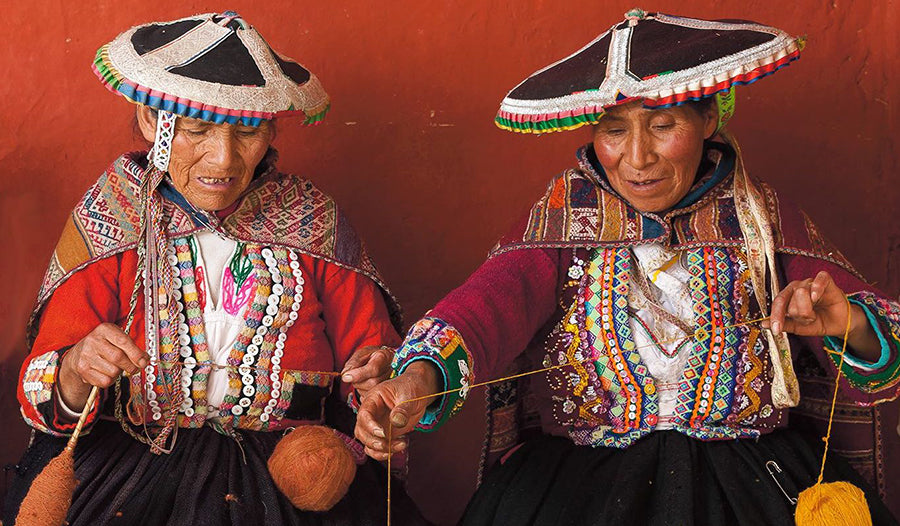
THE SECRET LIVES OF BOOKS
 Image: Nicolasa Condori and Hilaria Corpora, Spinners, Pitumarca, Peru - cover of The Human Thread (2019) © Joe Coca Photography
Image: Nicolasa Condori and Hilaria Corpora, Spinners, Pitumarca, Peru - cover of The Human Thread (2019) © Joe Coca Photography
With just over a week until the Selvedge Textile Literary Festival we're taking a closer a look at some of our speakers and their work. Today, we're delighted to focus on Linda Logan, founder, CEO and Creative Director (until 2005) of Interweave Press, and founder of Thrums Books, a niche press focusing on Indigenous textiles and their creators. She kindly shared an extract of her talk with us ahead of the festival.
On the one hand, books are fixed, stuck in time, immutable. On the other, they have secret lives based on the relationships, known or unknown, among the people who read them. (Think Gutenberg Bible!) You could compare the understory of a book, the human readership, to the mycelium of mushrooms. It can grow far and wide in secret, only to pop out in unexpected places and times.
The books I’ve published under the Thrums imprint have had readerships modest in number but with sometimes surprising effects. I think of Maya Gods and Monsters, a handsome and somewhat quirky little book by Carol Karasik. It was a hard sell from the beginning. Just didn’t catch on. But at some point a year or two in, one of the major distributors of books to public schools noticed it and began ordering by the hundreds. Now Itzamna and K’Inich Ahau are included in some districts’ curricula, right up there with Zeus, Athena, and Osiris. Now there’s a generation of school kids who might have heard of Grandmother Moon, who weaves together in our clothes “all the rhythms, all cycles, all songs.”
 Image: Women of the Multicolores cooperative, Guatemala. © Joe Coca Photography
Image: Women of the Multicolores cooperative, Guatemala. © Joe Coca Photography
The first book Thrums published, Weaving in the Peruvian Highlands: Weaving Patterns, Dreaming Memories, was conceived as a guide to Andean textiles for tourists to pick up as they were encountering all the wonderful hats and skirts and mantas that make the streets of Cusco such a visual kaleidoscope. It has served that purpose well, but it has also found a readership in the U.S. and beyond, enticing people to travel and visit (or dream about doing so) and appreciate the Quechua culture in all its aspects. It’s in the shared consciousness of at least ten thousand people; they don’t know each other, but they know where the people wearing some of those striking hats and vivid carrying cloths come from, and even a little bit of how they live. There’s a shared appreciation of another culture, which now maybe doesn’t seem so strange.
 Image: Guatemalan members of Multicolores, who are featured in the book Rug Money. © Joe Coca Photography
Image: Guatemalan members of Multicolores, who are featured in the book Rug Money. © Joe Coca Photography
Another example: Rug Money: How a Group of Maya Women Changed Their Lives through Art and Innovation. This story of a Guatemalan rug-hooking cooperative, born out of need, nurtured with care, has helped usher scores of rural Maya women from dead-end poverty to sustainable lives, respect in their communities, and hopeful futures for themselves and their families. Like most Thrums Books, Rug Money devotes much space to telling the stories of the individual weavers themselves. The focus is as much on them as on the splendid rugs they create. The message is that there’s human endeavor behind the work, and that’s an important source of its value. A rug is more than a rug. It’s a manifestation of a singular person’s life and experiences and will and creative urge. For the women we profiled in the book, seeing themselves in those pages has been a kind of validation. It puts them on equal footing with the people who buy the book, buy the rugs. It breaks down the “us-them” character of many cross-cultural transactions.
So look at your book shelf. Look at those stiff spines, those reams of paper, those unchanging words, page after page. Now imagine each book as a portal into the cultural consciousness of the hundreds or thousands of other people who have read it. Imagine the hidden lives of those books, and the human lives they have affected. Just imagine.
--
The Selvedge Textile Literary Festival takes place on Saturday 2 April. Linda will share some stories from her years of publishing Thrums Books, whose aim has been to tell the human stories behind the cloth and to reflect on the importance of cloth in the history and social evolution of a culture.
Book your ticket and find out more here:

